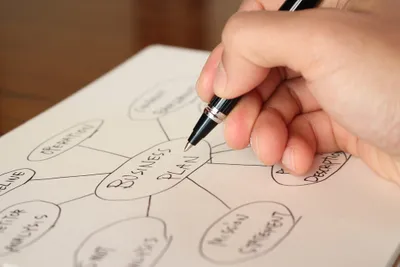Mind mapping is a powerful and simple problem-solving technique developed by Tony Buzan in the 1960’s. Mind maps can be described as diagrams used to “map out” your ideas. It’s a creative and logical technique which allows your brain to quickly connect and analyze vast amounts of information. A key component of all mind maps is that they use one core concept from which the organizational structure radiates outwards. Much like a city map, a mind map consists of major highways (primary thoughts) which appear to radiate from the city center (main idea). It also involves smaller roads (secondary thoughts) which connect one idea to another.
Mind maps are so effective because they incorporate the brain’s natural cortical skills of words, colours, numbers, symbols, logic, rhythm and spatial awareness into a single tool. Mind mapping can be used to improve any area of your life. There are seven things you will need to do in order to create your own mind map…
1. Start in the Middle of the Page
Starting in the middle of a blank piece of paper gives your brain the freedom to look at your main idea from all directions and visualize solutions spreading out and multiplying.
It helps keep your main idea foremost in your mind while simultaneously allowing you to explore other avenues which flow from it. In this way you never lose sight of your central idea.
2. Use an Image for your Main Idea
This is because “a picture is worth a thousand words” in relation to how your brain processes information. You will find an image or picture more interesting, memorable, and inspirational plus it will help keep your attention focused.
Another advantage of using a picture is that it helps stimulate your imagination and creativity.
3. Use Lots of Different Colors
Your brain is stimulated by colors and will find them exciting, vibrant and fun. Colors can also elicit an emotional response, thereby enhancing memory and productivity. They also add fantastic amounts of energy to your thinking and help keep your brain activated.
Color, pictures and images are the first things an infant sees and as such play a powerful role in the brain when it comes to information processing.
4. Connect your Branches from your Main Idea Outwards
Your main branches should flow outwards from your central idea and secondary, tertiary, etc., branches should flow from the preceding branches. This is because your brain works in a similar fashion. It automatically makes connections between multiple ideas. It works by association, bouncing ideas off one another.
Connecting the branches helps stimulate your brain to make even more associations and helps improve your memory.
5. Curve your Branches
Do not use straight lines when connecting your ideas or branches. Why? Because your brain does not work this way. It doesn’t think in a linear fashion plus it’s boring to your brain and stifles creativity.
You need to keep your brain interested and involved, not give it reasons to wander off to think about something more exciting. Straight lines promote rigidity while curved lines promote creativity and flexibility.
6. Use One Word Per Branch
This is because brevity keeps you focused on the solution and simplicity is more powerful. It also allows for more flexibility and creativity in creating more branches.
One word should be enough to trigger your thoughts and memories associated with the line and image they represent.
7. Use Many Images Throughout
Once again “a picture is worth a thousand words” comes into play when creating your mind map. These images should be smaller than that of your central image but can still pack a punch in regards to stimulating your creativity and keeping your memory sharp.
Research has shown that a combination of words and pictures resulted in a 6x improvement in memory over words used in isolation.










